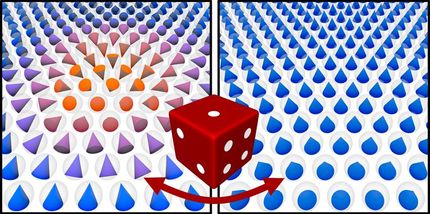New combinations of materials for producing magnetic monopoles
Advertisement
The new materials system consists of regular arrays of superconducting YBaCuO-dots covered with an extremely thin permalloy film. A shortly applied external magnetic field leads to the creation of supercurrents within the superconducting dots. These currents produce a complex magnetic field pattern, which is inscribed into the permalloy film above.
Magnetic patterns such as monopoles or skyrmions (stable vortices) are promising options for fast and energy efficient data storage. However obtaining and manipulating such magnetic structures is not easy. Now, Dr. Sergio Valencia and his colleagues at HZB, in collaboration with the materials science institute of Barcelona, have discovered an interesting new materials system which could do the trick. The samples consisted of regular arrays of superconducting YBaCuO-dots, approximately 20 micrometer in diameter and coming in different geometries. Valencia and his team covered these microstructures with an extremely thin film of ferromagnetic iron-nickel-alloy, a so called permalloy.
Complex magnetic patterns
The experiments were done at low temperatures (50 K), allowing the YBaCuO-dots to be superconducting. To change the magnetic domains inside the permalloy, an external magnetic field, perpendicular to the sample plane, was shortly applied. This external field, not enough to reorient the magnetic domains of permalloy, lead to the creation of a so-called supercurrent within the superconducting dots. Such superconducting currents do persist even after the removal of the external magnetic field and produce themselves a complex magnetic field pattern.
Mapping at BESSY II
It is this magnetic pattern, which does rearrange the magnetic domains of the permalloy film on top. It was possible, to reorient all domains pointing toward or away from a common centre, similar to magnetic monopoles. Valencia and his colleagues were able to map the magnetic domains of the permalloy by means of X-ray photoelectron emissions microscopy (X-PEEM and XMCD) at BESSY II.
Monopoles and skyrmions
Computer simulations reaffirm how such magnetic patterns are created in the permalloy film via the interaction with the superconducting dots. Choosing different geometries and arrangements of dots can produce and control a multitude of exotic magnetic patterns similar to monopoles as well as skyrmions, a type of stable vortex. "I am quite optimistic that it is possible to miniaturise such patterns to facilitate their implementation in magnetic memories, for example. What is more, we even have some ideas on how to stabilise such magnetic structures at room temperature", Valencia says.






























































